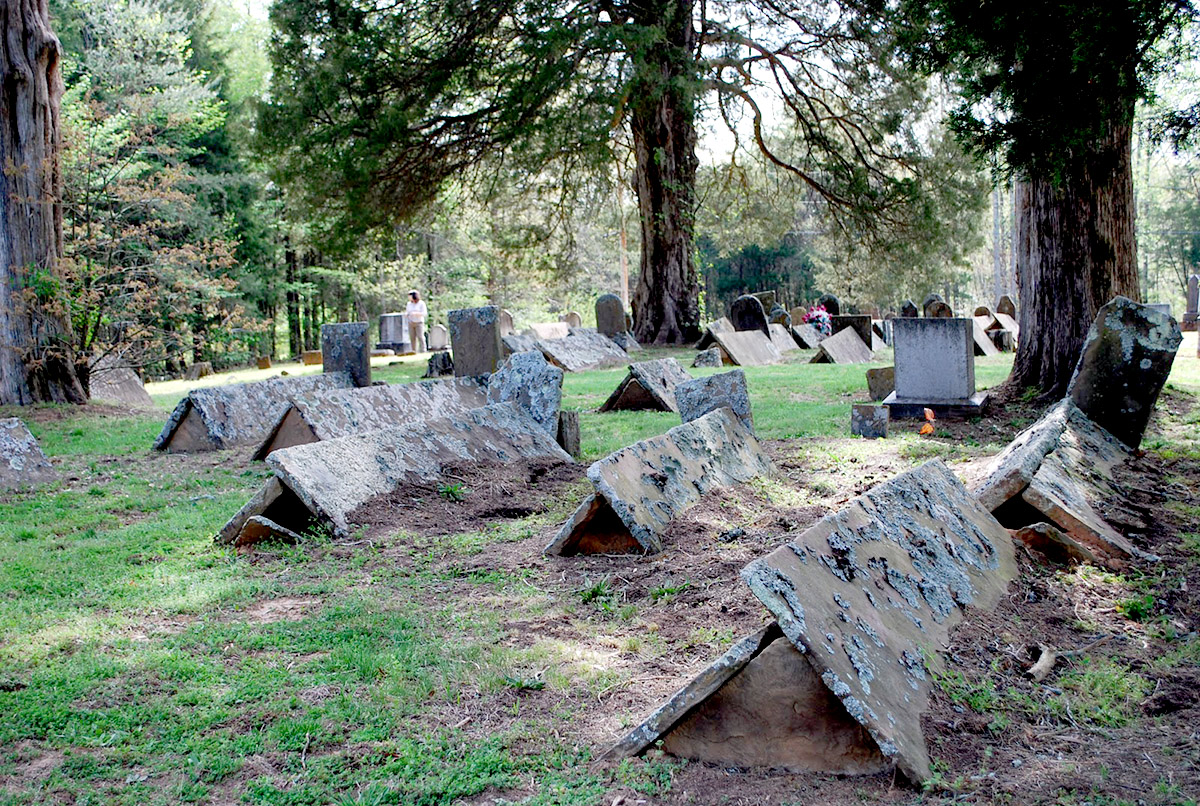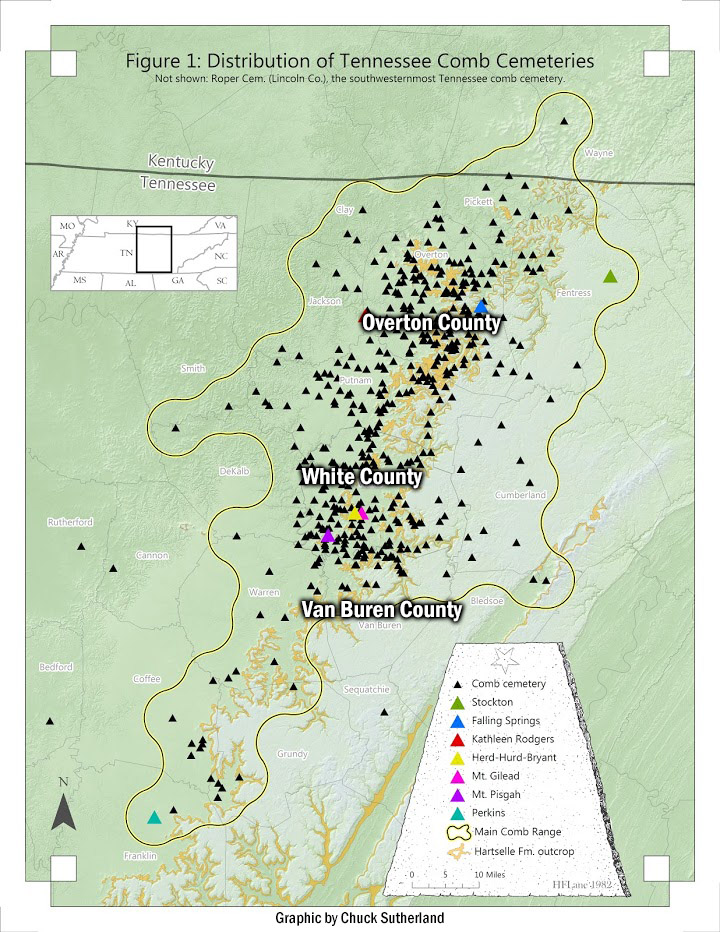Comb (or Tent) Graves = "Born" in White County, TN?

Visitors who are not familiar with White County, Van Buren County and some of their neighboring counties are often surprised when they pass an old cemetery and see a scene such as the one above. I grew up seeing lots of these kinds of graves but didn’t realize until my middle-adult years that, with a few exceptions, they only appear in a nine-county area around White County and Overton County in eastern Middle Tennessee, OR places to which people from those counties migrated.
Research suggests that comb / tent graves originated in White County, TN in about 1815.
Excerpts from "The Tennessee Comb Grave Tradition" by Richard C. Finch
The content of this article is almost entirely excerpted from Finch’s research report–the most substantial source on this topic.
A "comb grave" is a burial that features a grave cover made, normally, of two rectangular slabs of stone leaned together to form a gable roof over the grave. The term "comb" signifies "the crest or ridge of a roof." Combs have also been likened to pup tents and persons unfamiliar with the correct name commonly call them "tent graves." However, comb grave is the proper name for this traditional style of grave cover, and its essential form is that of a gable roof set directly on the grave, with no supporting walls. The above-ground space beneath the "roof" is normally empty, not filled.
Richard C. Finch
In Tennessee, over 3646 extant combs have been identified in over 511 cemeteries scattered along a NNE-SSW-trending band paralleling the western front of the Cumberland Plateau. Comb graves are most common in older graveyards lying on the Eastern Highland Rim, below the Plateau.
Two Distinct Areas of Comb Grave Concentration: Caney Fork Valley Group (White County) and Overton County Group

Although at least 72 comb cemeteries are associated with churches, the majority are local graveyards or
family plots not associated with church buildings.
Comb graves are known to be present in eight other Southern states (Alabama, Arkansas, Kentucky, West
Virginia, Texas, Mississippi, Louisiana, and North Carolina) and also in eastern Oklahoma, culturally part
of the Upland South. However, Tennessee appears to have more comb cemeteries
and comb graves than all the other states combined. Additionally, the oldest known combs are found in
Tennessee graveyards. Probably, the comb grave custom is indigenous to Tennessee.
No comb graves have been found on the east side of the Cumberland Plateau!
Combs are normally constructed of stone, the preferred material being relatively thin slabs of sandstone
taken from the stratigraphic unit known as the Hartselle Formation, named for Hartselle, AL.
Clearly, by the mid-1820s the Tennessee comb grave tradition was well established in the White Co. area and strong enough to begin to spread to north and south. The comb grave style appears to have “caught on” and spread rapidly throughout its full range.
The Old Union Cemetery in southern White County, TN has one of the largest number of comb graves, with 102 combs. The Mount Gilead Cemetery has 138 and the Mount Pisgah Cemetery has 126. All of these cemeteries are within 10 miles of each other.
The Big Fork Cemetery, where Daniel Haston and some of his immediate family members are buried, contains about 40 comb graves.
The use of comb graves peaked in the 1876-86 decade in White and Van Buren counties.
It seems that the comb grave custom as known in the Upland South originated in Tennessee, in the White Co. area, in the 1815-1820 period. The use of combs spread rapidly throughout the main Tennessee range, achieved a popularity that greatly exceeded that of other types of grave covers, and, as discussed below, was later carried into other areas.
Purpose of the Comb / Tent Graves?
“What was the purpose of combs?” is a commonly asked question, one for which there is no definitive or “one size fits all” answer.
The most common reason cited was to protect the grave from rain. The second most common reason given was to protect the grave from animals, whether domestic or wild. At least one informant said that one purpose for the combs was to make the grave more permanent, less likely to be hidden over time. Oddly enough, the retired stonecutter said he knew of no reason for combs other than people wanted them.
Having grown up where these graves are common, to me, the most sensible purpose is protection from animals–wild and domestic. Some graves are very shallow due to the rocky soil and manpower needed to dig them quickly. Some kind of impenetrable coverage was needed to prevent wild animals from digging up the bodies. But, the most dangerous-to-graves animals were cattle or hogs that often grazed freely through cemeteries. Headstones were frequently knocked over and graves ruthlessly trampled by these domestic animals.
A variety of ideas have been suggested to account for the “why” of combs, i.e., the purpose served by placing a comb over a grave. Protecting the grave seems to have been a motive, but there is no definitive single reason for combs. It is likely that different reasons motivated different people to erect combs, but that ultimately the comb became a highly popular style, indeed the dominant grave style in numerous small graveyards within the comb range. And style alone was probably sufficient reason for many.single reason for combs. It is likely that different reasons motivated different people to erect combs, but that ultimately the comb became a highly popular style, indeed the dominant grave style in numerous small graveyards within the comb range. And style alone was probably sufficient reason for many.
Much More About Tent/Comb Graves in Tennessee
If you appreciated this article, please share it with others who might also enjoy it.


6 thoughts on “Tent Graves: A Middle TN Phenomenon”
Thank you for this article! We wondered if it was to protect the grave from cattle walking across graves
I think you were guessing right, Debbie.
Dr Finch gave a very interesting talk about the graves a few years ago during the speaker series the state parks sponsored. Thanks for sharing. I have been told one of my relatives was a stone cutter. He did a lot of stones in the Cherry Creek and Yankeetown sections of the county. He usually marked the stones he did with a star with a dot in the center.
We wondering when visiting the old cemetery in Sparta, TN. Thanks for posting this interesting article!
Doyle cemetery has 5 or 6
The information contained in this article has historic value. Thank you